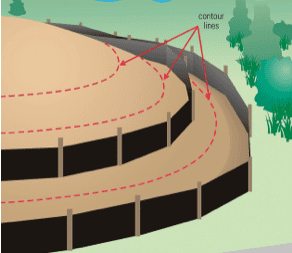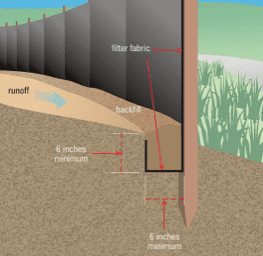Three Key Strategies
Soils washing off construction sites typically travel down roadways into street drains and out through pipes to the nearest river, stream, lake, or pond. Accumulation of these sediments severely impacts the quality of local waters, smothering life and blocking flow. To avoid such devastating impacts — and the fines and work stoppages that could result — follow several basic construction site stormwater best management practices.
1. Protect storm drain inlets
Protecting storm drain inlets is a temporary measure, but critical to ensuring sediment does not get into local waters during construction projects. Such drain inlets may be on-site in the midst of the disturbed area or down-gradient along the street. Strategies for protecting inlets will depend on site conditions and whether runoff velocities are likely to be high or low. They can include straw or hay bale barriers, gravel and wire mesh filter, block and gravel inlet protection, or basin inserts. For more information, click here.
2. Conduct regular inspections
Walk your construction site either once every 7 calendar days or once every 14 calendar days and within 24 hours of a 0.25-inch storm event to determine where you may have issues with controlling erosion or stormwater impacts. If problem locations are identified, take appropriate measures to remedy. More information is available at EPA's Construction General Permit website https://www.epa.gov/npdes/2017-construction-general-permit-cgp#documents.
3. Stabilize Soils on Site
Install and maintain erosion and sediment controls throughout the entire construction project so they operate effectively to control stormwater discharges.
This should include such strategies as:
- minimizing clearing in the design of a project
- minimizing the amount of exposed soils through better phasing of a project
- stabilization of construction entrances
- proper installation and maintenance of silt fences, coir logs, and other erosion control practices.
For more information, see the Massachusetts Clean Water Toolkit.


For silt fences to be effective, they must be properly installed and maintained. Note the proper installation shown in the above images.
Source of images: “Erosion and Sediment Control: A Guide for Individual Building Sites” by LCRA.
More information is available on EPA’s Construction General Permit at:
https://www.epa.gov/npdes/2022-construction-general-permit-cgp
What Developers Need to Know
Training Videos and Interactive Training Modules
To help advance your understanding and know-how with respect to stormwater management for development and redevelopment projects, you have two options to approach training here:
- Choose from among the 19 individual videos listed below and learn about topics that most capture your interest, or
- Choose from among the interactive training modules that make use of the videos to give you a more complete training experience (scroll down to see the list of modules).
These materials are based on a series of trainings held in June 2023 developed in partnership with the Pioneer Valley Planning Commission, Neponset River Watershed Association, and the Center for Watershed Protection thanks to a grant from the MassDEP MS4 Municipal Assistance Program.
Overview of Massachusetts Stormwater Regulations: What Developers Need to Know - June 22, 2023
- An Overview of Massachusetts Stormwater Regulations - Phil Paradis, Beta Group (9 min, 30 sec)
- Consideration of Risk During Design – Scott Turner, Environmental Partners (3 min, 46 sec)
- A Case Study: Gallery Automotive – Scott Turner, Environmental Partners (7 min, 27 sec)
- A Case Study: FM Global – Scott Turner, Environmental Partners (9 min, 15 sec)
- A Case Study: “Smart” Reuse – Dayton Marchese, Opti (9 min, 55 sec)
- Considerations When Hiring Engineering Consultants – Phil Paradis, Beta Group (4 min, 0 sec)
- Best Practices of Erosion & Sediment Control During Construction – Carol Wong, Center for Watershed Protection (18 min, 21 sec)
- Site Inspections: Perspectives from the Town of Norwood – Holly Jones, Norwood Conservation (25 min, 30 sec)
- Challenges Face on Job Sites – Bill Moynihan, Hatfield Construction (9 min, 45 sec)
Design: Picking the Best Stormwater Solutions for Your Site - June 29, 2023
- Introduction to Best Stormwater Solutions for Your Site - Deb Caraco, Center for Watershed Protection (15 min, 12 sec)
- Stormwater Updates to Massachusetts Wetlands & 401 Regulations – Lisa Rhodes, MassDEP (22 min, 5 sec)
- A Case Study: Devens, MA – Neil Angus, Devens Enterprise Commission (14 min, 17 sec)
- Stormwater and Soils: What you Need to Know and a Brief Activity – Sandy Brock, Nitsch Engineering (10 min, 42 sec)
- Using the EPA’s Stormwater Performance Curves – Theresa McGovern, VHB (11 min, 19 sec)
Post Construction Operation and Maintenance - June 30, 2023
- Post Construction Stormwater Regulations in Massachusetts – Newt Tedder, US EPA (6 min, 9 sec)
- Importance of Maintenance on Stormwater Practices – Sean Donlon, Simpson Gumpertz & Heger (13 min, 43 sec)
- Designing Stormwater Practices for Easier Maintenance – Rob Roseen, Waterstone Engineering (13 min, 22 sec)
- Retrofitting Existing Properties - Rob Roseen, Waterstone Engineering (15 min, 1 sec)
- A Case Study: BMP Retrofit and Optimization, Little Hale Creek, Durham NH - Rob Roseen, Waterstone Engineering (12 min, 16 sec)
